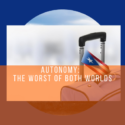Second in a three-part series on “autonomous commonwealth” as a failed territorial regime in Puerto Rico
By Howard Hills
The advent of “Balzac citizenship” would not have become the historic dilemma that it is for Puerto Rico today if the Congress had established a mechanism for the people to choose between statehood and nationhood. If an informed process of self-determination had led to a vote for nationhood then a transition to separate sovereignty, nationality, citizenship and constitutional order could have been achieved.
But the choice between statehood and nationhood as a future status was not allowed, because the “autonomists” in Puerto Rico convinced themselves, the “commonwealth” party and those in Congress responsible for territories that there was a third alternative.
The autonomist fantasy
That alternative was to make the less perfect status of territory incrementally even less imperfect, despite its already being not remotely as perfect as statehood.
In a sense, the Puerto Rico “autonomists” embrace “Balzac citizenship” doctrine of forced relocation to a state for equal rights. The strategy was to legitimize the denial of equality in the territory as leverage to “enhance” the “commonwealth” regime.
The autonomists were even willing to sacrifice any claim or right to achieve statehood for the U.S. citizen body politic in the U.S. territory at some time in the future. That is why the autonomists drafted the “commonwealth” constitution that was adopted in 1952 without any mention of future statehood.
That is also why autonomist leaders joined with U.S. territorial policy officials in the federal government to persuade the United Nations in 1953 to treat Puerto Rico as “decolonized” when that clearly was not true.
The worst case scenario
In a real sense, the absolute worst-case scenario for Puerto Rico is being a U.S. citizen populated territory without a federally sponsored mechanism for an informed democratic choice between future statehood or nationhood.
The worst part of this worst case scenario is that many of the educated, hard working, entrepreneurial, motivated risk takers and creatively gifted citizens who do have a choice vote for statehood by relocating to the states. Citizens who would choose to stay and build their families, neighborhoods, communities and bring the island up, make the Hobson’s choice Taft imposed in his own deal with the devil in the Balzac ruling.
This worst-case scenario which has now been played out gradually for nearly a century, reached culmination in the early 2000s, and is happening right now.
Instead of bringing eventual statehood to Americans in Puerto Rico, the Balzac ruling mandated that Puerto Ricans with U.S. citizenship who don’t like inequality bring themselves to statehood.
That is, in order to acquire full and complete U.S. citizenship, Americans in Puerto Rico were forced to migrate to the mainland to live under the political order of statehood with equal rights of citizenship.








No responses yet